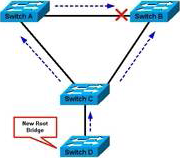If a switch receives a superior BPDU and goes directly into a blocked state, what mechanism must be in use?
A . root guard
B . EtherChannel guard
C . loop guard
D . BPDU guard
Answer: A
Explanation:
The root guard feature protects the network against such issues.
The configuration of root guard is on a per-port basis. Root guard does not allow the port to become an STP root port, so the port is always STP-designated. If a better BPDU arrives on this port, root guard does not take the BPDU into account and elect a new STP root. Instead, root guard puts the port into the root-inconsistent STP state. You must enable root guard on all ports where the root bridge should not appear. In a way, you can configure a perimeter around the part of the network where the STP root is able to be located. In the following figure, enable root guard on the Switch C port that connects to Switch D.
Switch C in figure below blocks the port that connects to Switch D, after the switch receives a superior BPDU. Root guard puts the port in the root-inconsistent STP state. No traffic passes through the port in this state. After device D ceases to send superior BPDUs, the port is unblocked again. Via STP, the port goes from the listening state to the learning state, and eventually transitions to the forwarding state. Recovery is automatic; no human intervention is necessary.
This message appears after root guard blocks a port:
%SPANTREE-2-ROOTGUARDBLOCK: Port 1/1 tried to become non-designated in VLAN 77. Moved to root-inconsistent state

Reference: http://www.cisco.com/c/en/us/support/docs/lan-switching/spanning-tree-protocol/10588-74.html

Leave a Reply